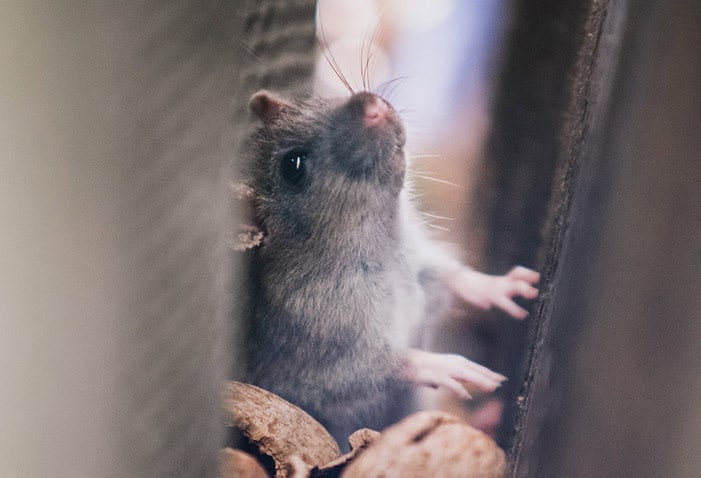Mice can cause a lot of annoyance, especially if they move into your home. Unfortunately, mice are so small that when they hide in your house (or yard), chances are great that you’ll have a really hard time finding them unless you follow a step-by-step plan.
The first time I saw a mouse in our house, I did a ton of research: I wanted to find and get rid of it as soon as possible. However, it wasn’t as easy as I first thought.
I made a huge mistake. I didn’t expect an entire family of mice to live and hide in the house… I learned the lesson.
In the upcoming years, I’ve managed to keep mice out of my house and yard and I’ve also helped many of my friends, neighbors, and relatives get rid of them.
So, without further ado, let’s see the common hiding spots where mice love to spend their time in your home.
Where Do Mice Hide In a House (or Apartment)?
While it’s true that mice usually move into homes during the fall and winter months, that doesn’t mean that you can’t find an infestation in the spring or summer.
Mice are nocturnal animals and pretty sensitive to bright lights, therefore, most of the time, they are active at night. Most mice usually stay hidden during the day, however, you may see (or hear) one in the daytime: that’s often a sign of a larger infestation.
Like most pests, mice love to hide in rooms with clutter that are close to sources of food. Thus, they are most likely to settle in pantries, attics, and wall voids. Cluttered basements and garages are also among their favorite places.
Let’s see where mice hide and build their nest in your house.
1. Pantry and Kitchen
Kitchens and pantries are more popular among mice during the winter months when it’s harder to get enough food outside. Even one single mouse can spread many kinds of diseases, so it’s especially important to keep them away from your food, cutlery, and kitchen surfaces.
Common hiding spots:
- Behind or under (sometimes inside) the stove
- Behind, under, or inside kitchen cabinets
- Under or behind the dishwasher
- Behind the refrigerator
- Inside air ducts
2. Basement and Garage
In garages and basements, mice can find ideal hideouts all year round: these are usually low-traffic areas with many ideal places for nest building. This is even truer if you store some food or your garbage can in these places.
Here are where they usually hide:
- Near the heater
- Inside storage boxes
- Under piles of clutter
- In the car, especially in winter, and if you don’t use it for several days or weeks (first look under the hood, inspect the wires for any damage, then check the upholstery, air vents, and insulation).
3. Attic
A cluttered attic is an ideal hiding place for mice (and other rodents, such as rats): it provides shelter and protection against the cold while being much less busy than other areas of the house. Mice inside a home often come from the attic.
Also, food is within reach: a mouse can easily squeeze through tiny cracks and holes and get into your pantry or kitchen from the attic in no time. Therefore, it is not uncommon for mice to build their nest in the attic.
Mice can get into your attic through relatively small openings, so make sure you fill all the gaps after you find an infestation.
Common hiding places in the attic:
- Under and inside piles of clutter and old clothes (mice are more likely to be under those piles that are closer to the walls)
- Inside stacks of boxes (they love cardboard)
4. Bedroom
Bedrooms are not the most common places where mice usually spend their time, however, in the case of a larger infestation or if the food sources are close to the bedroom (and the bedroom is not too busy), they might appear. And yes, they can easily get upstairs too.
You should check the following hiding places:
- Under, behind, or inside closets (they like closets full of clothes)
- Under and inside the bed
- Behind, under, or inside the couch and armchair
5. Other Common Hiding Spots
- Crawl spaces
- Inside wall voids
- Where pipes enter your home from the outside
- Inside insulation
- In suspended ceilings
- Behind the washing machine
- In the laundry room
FYI: If you want to get rid of mice for good, make sure you also learn about the main reasons why they keep coming back to the same property.
Find Mice and Their Hidden Nest: Follow the Signs

If you suspect there’s a mouse (or mice nest) in your house and wondering how you could find it, you can check the above-mentioned places one after another. However, depending on the size of your home, it can be a really tedious task.
You are better off following the telltale signs and traces that mice leave behind, and place your traps where you expect high mice activity. This is a proven strategy.
What are those signs and how to detect them?
- Droppings. If you find mouse feces, you can be sure there is at least one mouse (often there is more) in your home (here is a guide that helps you differentiate mouse droppings from other types of pest droppings). Usually, the more droppings you find in a place, the more likely mice spend their time there. Do not touch droppings with bare hands because they might contain harmful germs.
- Mouse urine smell. It has a very strong, ammonia-like odor that is more noticeable near the hiding places. Pets have a better sense of smell and can help you in your search.
- Gnaw marks. The more gnaw marks you find, the more likely that mice like to spend their time in that place.
- Scratching sounds. When mice are active (usually at night), you can hear all kinds of strange noises. Try to identify where those sounds come from.
Pro Tip: If you suspect that you’ve found a hideout or a runway along the wall, you can confirm your guess by pouring some baby powder or flour on the floor or surface and checking the footprints the next day.
How to Make Mice Come Out of Hiding and Catch Them on the Cheap? – My Favorite Methods

FYI – I’ve written a whole article about how you can get rid of mice fast (you can find it here) in which I’ve shared my best tips (don’t worry about the ‘apartment’ word in the title, I tried and tested the methods and they all work just as well in a house).
Here is how you can make your home mouse-free on the cheap:
1. Use a Bowl with Peanut Oil
This is by far my favorite method of catching mice and other small rodents. It’s so simple and effective. Even if you’re not a big fan of DIY, you’ll love this one.
Here is how it works:
- Take a large plastic bowl.
- Pour some peanut oil into it.
- Put the bowl in a place where you suspect high mice activity and make it easy for mice to get into it (for instance you can put a small container or box next to the bowl)
That’s it. When done right, mice will come out of hiding and they won’t be able to get out of the bowl once they get into it because of the slipperiness of the peanut oil.
You can easily catch several mice alive during a single night using this method. And the bowl doesn’t even have to be very close to the hiding spots.
If you’re more of a visual type of person, check out the video below:
2. Use a Humane Mouse Trap
Instead of the previous method, you can use some humane mouse traps. They’re simple and reusable devices that catch mice alive (hence the name).
Placing some humane mouse traps close to the walls, closets or cabinets is a great way to make mice come out of their hiding spots. I suggest you use a small amount of peanut butter as bait and place it at the very end of the trap.
You can also make your own humane trap: just make a quick search and you’ll find plenty of articles and videos on how you can do that.
As I mentioned before, you can find more proven methods and helpful tips to catch mice in this article.
What to Do After You Caught All the Mice?
Once you get rid of mice, don’t forget about prevention (you can read my best tips in this article).
Go ahead and find the holes and small cracks and seal them up with steel wool and fix them with caulk as CDC recommends to prevent reinfestation. If you miss this step, chances are great that you will have to start the whole process from scratch.
Frequently Asked Questions
Where do mice nest in a house?
Mice usually choose a less busy and well-hidden spot to build their nest. Attics, basements, garages, crawl spaces, suspended ceilings, and wall voids are the most common places.
What mouse species can live in my home?
Field mouse (including house mouse), deer mouse, white-footed mouse, and western harvest mouse are the most common species in the United States. In the UK, wood mouse, house mouse, harvest mouse, and yellow-necked mouse are the most widespread.
Where do mice hide in stoves?
It can be time-consuming to figure out where mice are hiding inside your stove. Often you’ll find them in or around the insulation or the stove vent. You’ll likely need to disassemble the device, so if you’re inexperienced, you’ll be better off asking for expert assistance (such as an exterminator or a pest control service).
How to make a mouse come out of hiding?
In brief: by offering food and limiting traffic in the affected area. In my experience, peanut butter works best. As an alternative, you can use soft cheese.
Why do mice hide during the day?
Usually, mice are active during the night (more precisely at dusk and dawn) and they sleep in the daytime. This way they can often also avoid humans.
How many mice live in my house?
If you have seen a mouse in your house, chances are great that there are more of them hiding somewhere nearby. A female mouse can breed all year round, so it can multiply really quickly. That being said, it’s not sure that they’ve already built a nest in your home but probably they will if you don’t act fast.
Photo: Flickr (alsteele)












